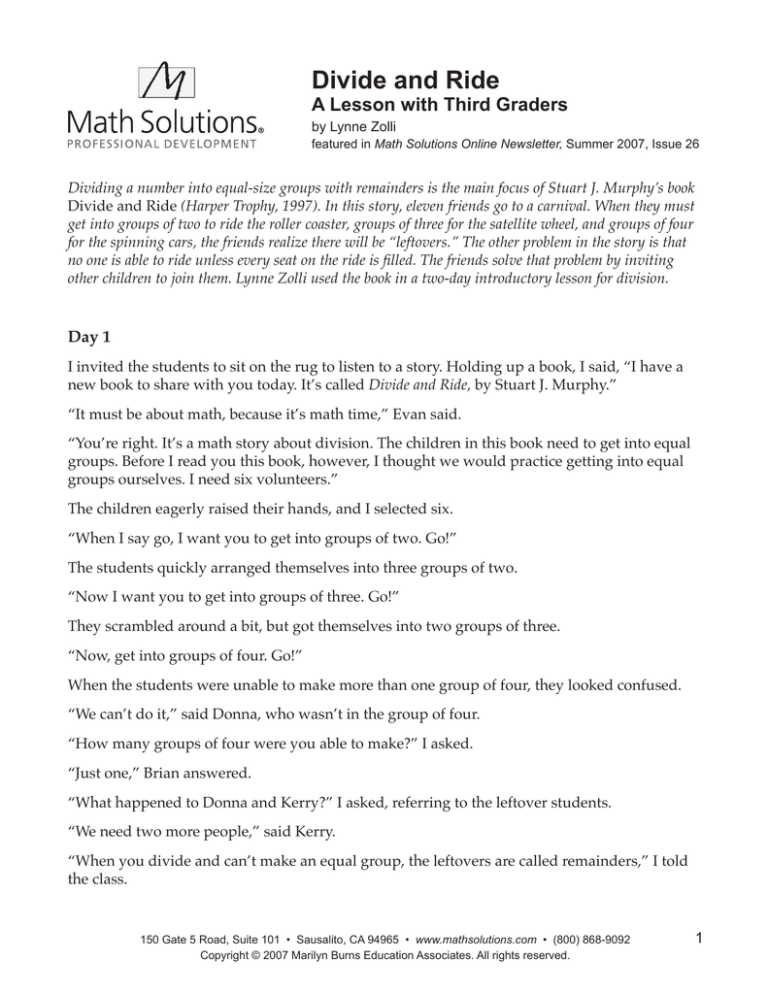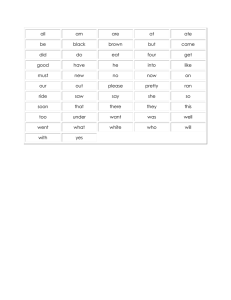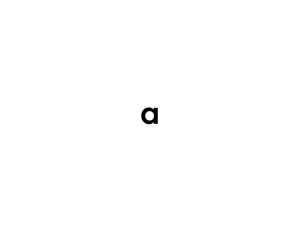
Divide and Ride
A Lesson with Third Graders
by Lynne Zolli
featured in Math Solutions Online Newsletter, Summer 2007, Issue 26
Dividing a number into equal-size groups with remainders is the main focus of Stuart J. Murphy’s book
Divide and Ride (Harper Trophy, 1997). In this story, eleven friends go to a carnival. When they must
get into groups of two to ride the roller coaster, groups of three for the satellite wheel, and groups of four
for the spinning cars, the friends realize there will be “leftovers.” The other problem in the story is that
no one is able to ride unless every seat on the ride is filled. The friends solve that problem by inviting
other children to join them. Lynne Zolli used the book in a two-day introductory lesson for division.
Day 1
I invited the students to sit on the rug to listen to a story. Holding up a book, I said, “I have a
new book to share with you today. It’s called Divide and Ride, by Stuart J. Murphy.”
“It must be about math, because it’s math time,” Evan said.
“You’re right. It’s a math story about division. The children in this book need to get into equal
groups. Before I read you this book, however, I thought we would practice getting into equal
groups ourselves. I need six volunteers.”
The children eagerly raised their hands, and I selected six.
“When I say go, I want you to get into groups of two. Go!”
The students quickly arranged themselves into three groups of two.
“Now I want you to get into groups of three. Go!”
They scrambled around a bit, but got themselves into two groups of three.
“Now, get into groups of four. Go!”
When the students were unable to make more than one group of four, they looked confused.
“We can’t do it,” said Donna, who wasn’t in the group of four.
“How many groups of four were you able to make?” I asked.
“Just one,” Brian answered.
“What happened to Donna and Kerry?” I asked, referring to the leftover students.
“We need two more people,” said Kerry.
“When you divide and can’t make an equal group, the leftovers are called remainders,” I told
the class.
150 Gate 5 Road, Suite 101 • Sausalito, CA 94965 • www.mathsolutions.com • (800) 868-9092
Copyright © 2007 Marilyn Burns Education Associates. All rights reserved.
1
Divide and Ride, continued
“Let’s look at the board and see what we’ve done mathematically. The first thing we did was
divide six students into groups of two.” I wrote 6 ÷ 2 on the board.
“How many groups of two were you able to make?” I asked.
The students answered and I completed the equation on the board: 6 ÷ 2 = 3.
“The six is the number of students, the two is the type of group you needed to make, and the
three is how many groups of two you were able to make,” I explained while pointing to the
numbers.
I continued with 6 ÷ 3 = 2, asking the students what each number stood for.
When I got to 6 ÷ 4, I explained there was one group of four and two students left over. “When
we record remainders, it looks like this,” I said, writing 6 ÷ 4 = 1 R2 on the board.
“This time I need seven volunteers who will get into equal groups.”
After selecting different students, I asked them to get into groups of two. They made three
equal groups with one student left over, and I recorded the equation on the board: 7 ÷ 2 = 3 R1.
“We’ll get into groups one more time so that everyone has a chance. This time we’ll have the
whole class get into groups of four when I say go. Go!”
Twenty-two children were present that day, so I knew there would be leftovers. There was a
great deal of noise as the children got themselves into groups of four, but the class managed to
get the job done.
“How many groups of four were you able to make?” I asked.
The students agreed there were five groups of four and two students left over.
“Would someone come to the board and write what we’ve done mathematically?” I asked.
Theresa, an extremely quiet student, raised her hand. She came to the board and wrote
22 ÷ 4 = 5 R2.
I then asked the class, “What does the twenty-two mean?”
Allie responded, “The number of kids in class.”
“What does the four mean?” I called on Josh.
“It’s how many kids are in each group,” he replied.
“And what does the five mean?”
“How many groups,” said Mickey.
“OK, good. Now, what does the two stand for?”
Kaleem answered, “The leftovers.”
“Now that you know something about equal groups, let’s read Divide and Ride and see why the
children in this book need to get into equal groups. Look at the cover. Where do you think this
story might take place?”
150 Gate 5 Road, Suite 101 • Sausalito, CA 94965 • www.mathsolutions.com • (800) 868-9092
Copyright © 2007 Marilyn Burns Education Associates. All rights reserved.
2
Divide and Ride, continued
The students thought it was Great America, an amusement park in the area.
I then read the entire book without stopping so the class could enjoy the story.
Day 2
I gathered the class together the following day and said, “In Divide and Ride there were eleven
friends. What kinds of groups did they need to divide into and why?”
The students recalled that the friends needed to get into groups of two for the roller coaster,
groups of three for the satellite wheel, and groups of four for the spinning car ride.
I passed out fourteen Snap Cubes to each student and asked each to make a train of eleven
cubes and to put the others aside.
“These cubes represent the eleven friends. I want you to put the cubes into groups of two,
because the seats on the roller coaster fit two people.”
I waited for a few moments and then asked, “How many groups of two did you make?” I
wrote 11 ÷ 2 = 5 on the board.
“Were there any leftovers?” I asked. I completed the equation: 11 ÷ 2 = 5 R1.
“The friends could fill five seats on the roller coaster, and one friend would ride alone,” I
explained.
We continued with the satellite wheel (11 ÷ 3 = 3 R2) and the spinning car ride (11 ÷ 4 = 2 R3),
putting the equations on the board.
“What if there had been a ride where the students needed to be in groups of five? Do you think
there would have been a student left over?” I asked.
Most of the class was sure that it wouldn’t work out evenly, but some students were uncertain.
The students used the cubes to check, and we added 11 ÷ 5 = 2 R1 to our list.
“I don’t think it will ever come out equally,” Mark said with a groan.
“Let’s keep trying,” I suggested.
We continued dividing into groups until we got to 11 ÷ 11 = 1.
“I remember the last ride they went on,” shouted Jenny. “All the friends could fit on the raft.”
“Do you remember how many seats were on that raft?” I asked.
The students remembered that there were fourteen.
“I have a new problem for you. If the eleven friends got on the raft, how many seats were left
over?”
“That’s easy,” David said, laughing.
“Explain it to me mathematically,” I said.
150 Gate 5 Road, Suite 101 • Sausalito, CA 94965 • www.mathsolutions.com • (800) 868-9092
Copyright © 2007 Marilyn Burns Education Associates. All rights reserved.
3
Divide and Ride, continued
“Fourteen minus eleven equals three,” he replied.
“I know another way using division,” Martha suggested. “They needed to be a group of
eleven, so fourteen divided by eleven equals one remainder three.”
“The three is left over, like in my problem,” David shouted.
“We can show both equations with our Snap Cubes,” I explained. “Make a train of fourteen.
Now the cubes represent seats on the raft ride. Snap off a train of eleven to show that the
eleven friends each have a seat. There are three seats left. You can think of this as fourteen
minus eleven equals three or fourteen divided by eleven equals one remainder three.”
The students were noticing the connection between subtraction and division, so I went back to
the roller coaster ride.
“The roller coaster ride had twelve seats. Make a train of twelve with your cubes. Take out a
group of eleven to show that there were seats for the eleven friends. How many are left over?
Let’s show it with an equation.”
I wrote 12 ÷ 11 = 1 R1 on the board. I also wrote 12 – 11 = 1.
“In the book, each seat had to be filled before the ride would start, so what did the eleven
friends do?”
“They invited a new friend,” Ellie said.
“Show me with an equation,” I said.
Ellie came to the board and wrote 12 ÷ 12 = 1.
“But two people fit in each seat, so it’s twelve divided by two equals six,” Mark argued.
“You are both correct,” I responded. “You need one group of twelve to ride on the roller coaster, but you need to sit in groups of two.
“Now I’m going to give you a new problem. At the end of Divide and Ride, the eleven friends
had made three new friends and now there were fourteen friends. I want you to put those
fourteen friends in groups of two, three, four, and five. You have fourteen Snap Cubes to help
you show how many groups you can make. Write your equations on a piece of paper.”
“Do we need a title?”
“Can we put them into other groups too?”
After answering their questions, I sent the students back to their desks to get to work and
began thinking of other lessons and activities that might help students better understand the
complexities of division.
150 Gate 5 Road, Suite 101 • Sausalito, CA 94965 • www.mathsolutions.com • (800) 868-9092
Copyright © 2007 Marilyn Burns Education Associates. All rights reserved.
4





